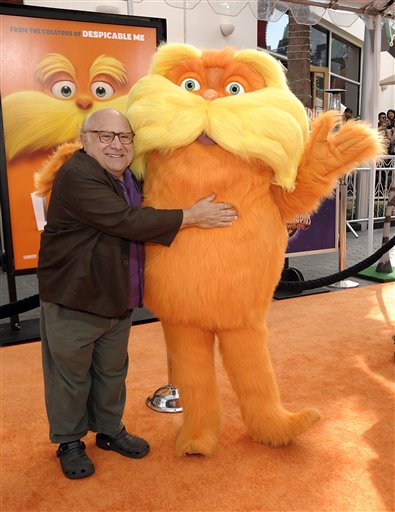Grade: 3 out of 4 Stars
Hollywood has had an obsession of sorts with turning the classic stories of Theodore Seuss Geisel, better known as Dr. Suess, into major motion pictures in recent years with the release of How the Grinch Stole Christmas in 2000, The Cat in the Hat in 2003, and Horton Hears a Who! in 2008. In honor of Dr. Suess’s 108th birthday on March 2, Universal Studios and directors Chris Renaud and Kyle Balda brought us The Lorax.
I must admit, it had been quite some time since I’d read Dr. Suess’s The Lorax prior to seeing the movie, but I remembered the gist of it, or at least I remembered the gist I gathered from the book back when I read it in first grade: chopping down trees is bad. I figured the movie be a little like WALL-E, and that’s exactly what I think the film was trying to be, but fell short of reaching WALL-E’s level of genius, creativity, and impact.
At first glance, The Lorax hits all the right notes: it’s colorful, it’s full of catchy songs, it drives home its anti-big business and pro-environmentalism message, and it’s even weaved in a love story between 12 year-old protagonist Ted (Zac Efron, 17 Again) and the high school girl he worships, Audrey (Taylor Swift, Valentine’s Day). While my initial reaction to the movie was primarily positive, I began to recognize after further investigation that the movie did a great injustice to the book.
In the movie, Ted and Audrey live in Thneedville, a town replete with manufactured goods designed to compensate for their utter lack of natural resources. In an effort to impress tree-loving Audrey, Ted sets out on a mission to find a man called “The Once-ler,” because according to his grandmother, the Once-ler will be able to tell him all about trees, and perhaps provide him with a real one instead of the plastic ones found in town. The Once-ler tells Ted the story of how his greed for the material of Truffula trees needed for his all-purpose invention, the Thneed, ultimately destroyed the forest.
Without knowing anything about the book at all, one would find the movie to be entertaining, light-hearted, and impactful. Complaints might stem from the drawn-out chase scene that causes headaches in 70% of viewers (WARNING: I made up this statistic and its probably exaggerated, but I know I felt a bit queasy), the unrealistic behavior of 12-year old Ted (24 year-old Zac Efron isn’t fooling anyone into believing he’s “17 Again”), and the rushed feeling of the final scene. Nevertheless, you can’t help but smile at the cute woodland creatures, laugh at the slightly snarky jokes courtesy of the Lorax himself, Danny Devito (It’s Always Sunny in Philadelphia), and remind yourself to take better care of our planet and think twice about the effects of industrialization.
The problem is this: the book is better and its messages run deeper. After watching the original 1972 cartoon production of the The Lorax, produced in part by Theodore Geisel himself, the differences between Geisel’s vision and modern Hollywood’s take became all too clear. In the movie, the Once-ler initially tries to compromise with the animals of the forest and the Lorax, who “speaks for the trees,” making him a more sympathetic figure. Dr. Suess’s original intent was to make the Once-ler out to be an apathetic, money-hungry man from the start, who would become a venerated figured whose name brandished everything in town but whose face was never seen, much like the addition of the “O’Hare Air” corporation in the film version. While the film’s O’Hare Air Company was an entirely Hollywood creation, it did reflect on our current habit of masking the damage we’ve done to the earth and our indulgence in unnecessary, environmentally harmful products like bottled water – one positive outcome of the film’s alterations.
There was no Audrey and no grandmother in the book, suggesting that Ted had an independent interest in nature, apart from the motivation to win himself a high school girlfriend. Although English teachers encourage us in our essays to “show” and not “tell,” the movie went overboard on the whole concept of “showing,” paying more attention to visual appearance and not enough to the poignant commentary of the Lorax in the book on capitalism, the pace of progress, and the importance of nature.
Because I understand the idea of artistic license, I do not condemn Hollywood’s portrayal of The Lorax, and I do not necessarily wish to deter anyone from seeing the film. It’s an enjoyable, fun movie with a positive message we’ve albeit heard before, but that bears repeating. Although I wish the movie would’ve attached itself more closely to the original story and incorporated more of Dr. Suess’s famed rhymes, I was not entirely disappointed as the credits began to roll. The bottom line: The Lorax inspired me and made me happy, the two things every quality children’s movie should do.

